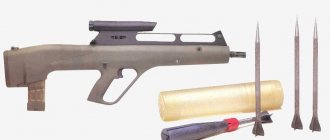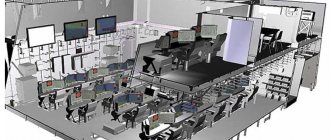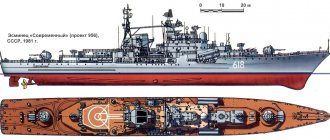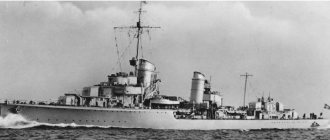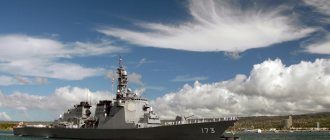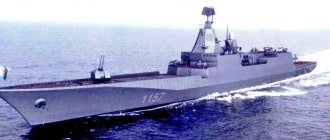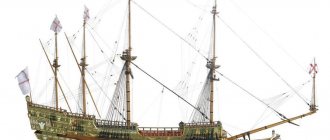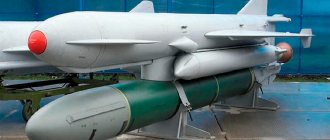Destroyers and torpedo boats
The same “Batum” After the successful combat debut of mine boats in the Russian-Turkish War of 1877-78, the search began for ways to transform this excessively coastal type of combat watercraft into something more autonomous and combat-ready.
In 1879, at the Yarrow shipyard in Great Britain, the first classic destroyer was laid down, which, in fact, became a model for similar ships right up to the beginning of the 20th century - the destroyer Batum, ordered by the Russian Naval Ministry: an all-steel ship with a displacement of 50 tons, armed with two mine (torpedo) tubes and capable of developing a huge speed of 22 knots for those times[1]. After construction, the destroyer under its own power (!) reached from England to Nikolaev, which no ship of this size had ever done before. Of course, no one limited themselves to one destroyer - during the 1880s, destroyers based on the Batum model appeared in many countries: Great Britain, France, Italy, Germany, Austria-Hungary, Spain, Japan and many others (the leadership was held for a long time by Russia, which only at the beginning of the 20th century lost its primacy to France and Great Britain). They all had similar characteristics - a displacement of 70-120 tons, a speed of 16-20 knots, a pair of small-caliber guns and a pair of mine vehicles. The main manufacturers of destroyers were the British and Thornycroft, the French Norman and the German Schichau. The Violet, a typical 400 ton British fighter, is a similar ship built domestically. In the bow there is a practically useless apparatus for throwing Murakumo pole mines, another analogue, the brainchild of Japanese shipyards. In the 1890s, the development of destroyer fleets went in several directions. Firstly, the evolutionary development of the classic destroyers - the successors of the Batum - continued: the displacement gradually increased to 150-180 tons, the speed increased to 25 knots, the mine devices traditionally located in the bow moved to the sides, and their place was taken by a cannon. Secondly, attempts were made to create larger mine ships - the so-called "mine cruisers", but the result was either small and weakly armed cruisers, or very large and slow destroyers. Finally, the last and most successful option was the banal strengthening of armament on the new destroyers due to an increase in displacement - the 27-knot and 30-knot [2] series of destroyers built in the second half of the 1890s with the same two or three mine vehicles received 75- mm cannon and 3-5 small-caliber rapid-fire guns. These ships could already catch up and destroy any destroyer of earlier projects and received the corresponding name - “torpedo-boat destroyer” or squadron destroyers (since these ships could already accompany battleships and cruisers on the open sea, and not just operate in coastal waters). Most developed European countries and Japan quickly switched from destroyers to destroyers, with the exception of France, which built almost three hundred 150-ton and 200-ton destroyers at the turn of the 19th-20th centuries and only by 1910 acquired a normal number of obsolete “fighters” [3 ] and the USA, where before the First World War mine ships were not built in commercial quantities at all.
Destroyers took the next step in development after the Russo-Japanese War - the battles of destroyers near Port Arthur and the passage of the Pacific squadron demonstrated that 200-ton destroyers are not suitable for trips to the ocean in principle (and 400-ton “fighters” sail across three seas they don’t withstand very well), and the armament of the “fighters” is clearly insufficient - another 75-mm cannon is needed, or better yet, more than one. The first step was taken by those with military experience: Japan laid down a large series of Kamikaze-class destroyers (450 tons, 6 - 76 mm guns), Russia - a series of Volunteer-class destroyers[4] (550-700 tons, 2 - 76 mm and 4-6 - 57 mm guns, later - 2 102 mm guns, 2 single-tube torpedo tubes), then similar ships began to be built in Great Britain, Germany, France and other countries. Since 1908, turbines began to be used as engines on destroyers, which made it possible, not on paper, but in reality, to achieve a 30-knot speed. However, in fact, the new destroyers were the same “fighters” increased in size, simply armed not with 76-mm, but with 100-mm cannons and not with single-tube, but with twin torpedo tubes.
“Novik” in person. And its German competitor V-25. We sacredly honor the tradition of not installing more than two guns and two torpedo tubes on one ship. British “alphabet” destroyer of 1918. American smooth-deck destroyer “Wicks”.
In 1913, the destroyer Novik was built in Russia, significantly superior to most destroyers that existed at that time in almost all characteristics (displacement 1360 tons, speed 36 knots, armament - 4 102-mm guns, 4 twin torpedo tubes, for the first time in the design there was the revolutionary principle was applied “why invest in half a century of operation if it will still be hopelessly outdated in ten years”, which made it possible to choose other construction materials and gave a huge gain in the mass of the hull).
| « | - Look, Admiral, at the deck: except for the stringer, in which the entire fortress is, everything else, which is like a roof, is rusted almost right through, the pipes, their casings, deckhouses, etc. - everything is worn out. Look at your destroyer, everything is like new on it; True, our destroyer has been without maintenance and without painting for six years, but that’s not the main point. Your destroyer is built from ordinary steel, and a design stress of 7 kg per 1 sq. mm is taken on it, as if it were a commercial ship that should serve for at least 24 years. Ours is built entirely from high-resistance steel, the voltage allowed is 12 kg or more, in some places up to 23 kg/sq.mm. A destroyer is built for 10–12 years, because during this time it becomes so outdated that it no longer represents a true combat force. All the gain in hull weight was used to strengthen combat weapons, and you see that in an artillery battle our destroyer will smash at least four to smithereens, i.e. division of yours, before they approach the firing range of their farts. | » |
| — From the memoirs of Academician Krylov | ||
In 1916-17, similar characteristics became standard for all destroyers of the warring countries. At the same time, most countries switched from 450-500 mm torpedo tubes to the standard caliber of 533 mm until today. Another novelty during the war was the appearance of leaders - destroyers, larger and more powerful than standard ones, designed to support the actions of their smaller brothers, as well as to accommodate the commanders of destroyer detachments. New types of weapons also appeared on destroyers - anti-aircraft guns and depth charges.
The old “alphabet” was good, but the new one is no worse. In the 30s and 40s, the British built so many middling ones like this that the English alphabet ended (destroyers were built in series of 8 ships: 8 with names starting with “A”, 8 with names starting with “B”, and so on) Z-31, one one of the most powerful German destroyers (some of the ships received a two-gun turret instead of a cannon located in the bow, which significantly worsened seaworthiness) “Le Fantask”, a French super destroyer Another middling one, the domestic “Gnevny”
In the interwar period, the development of destroyers continued in an evolutionary manner - 100-mm guns gradually gave way to 120-130 mm, two-tube torpedo tubes were replaced by three-four-tube ones. Almost all states organized the construction of new standard destroyers to replace aging ships of pre-war and military construction. The gradual increase in the cost of destroyers led to the revival of the class of destroyers, however, at a new level: destroyers were small and cheap ships whose armament corresponded to the destroyers of the First World War (the first destroyers, in general, were the “demoted” WWII destroyers) and intended for operations in minor naval theaters. At the same time, the opposite trend emerged - the creation of large ships with characteristics superior to standard destroyers[5]. The United States stood apart, having a huge fleet of smooth-deck destroyers built in the 1916-20s and began building new ships only in the second half of the 30s, quite quickly replenishing its fleet with hundreds of very decent destroyers that had a serious advantage - universal artillery main caliber[6].
"Fletcher", a classic station wagon And its main competitor "Kagero"
During the war, only the USA, Great Britain and Japan were engaged in large-scale construction of destroyers[7] - in other countries the fleet quickly faded into the background. Italy and Germany, after major losses of ships in 1940-42, tried to “give birth to a child in a month,” that is, to organize the construction of relatively large and at the same time simple destroyers, but in the end half of the laid down ships had to be blown up right at the shipyards so as not to fall to the advancing the Red Army and the allies who landed in Italy. For objective reasons, the USSR completely curtailed the construction of large ships, limiting itself to the completion of almost finished destroyers in the Baltic and Black Sea and work at the Far Eastern shipyards. During the war, destroyers were actively used for almost all conceivable and unimaginable purposes - they escorted convoys and warships, sank submarines, conducted radar patrols, searched for pilots shot down over the sea, landed and evacuated troops and supplied troops pinned to the sea with weapons and ammunition, stationed and were sweeping mines. Torpedo attacks on large enemy ships, for which this class of ships was created, faded into the background.
"Modern", the last of the domestic destroyers "Arleigh Burke", the hope and support of the American fleet
In the post-war period, the vector of development of destroyers took ships further and further away from their original purpose - torpedo attacks. Post-war destroyers already in the 50s became primarily anti-aircraft and anti-submarine defense ships, and from the 70s, after the adoption of various missile systems, torpedoes completely receded not even into the background, but into the third or fourth place, becoming as a means of combating submarines. And the destroyers themselves, in the course of evolution, gradually grew in size to light cruisers[8], and their place in the role of inexpensive and numerous units was taken by a variety of patrol ships, corvettes and frigates (which are already growing in size).
Development of destroyers at the beginning of the twentieth century[edit | edit code]
At the turn of the 19th and 20th centuries, steam turbines appeared in the design of destroyers. The first destroyer with a steam turbine was the English Viper (English HMS Viper), built in 1899. During trials, it reached a speed of 36 knots. Although the Viper itself soon broke in half and sank during a storm, the British Navy ordered several more destroyers with steam turbines. By 1910 they were already widespread.
American destroyer "Perkins" of the "Paulding" project (1909).
In 1905, England began building destroyers powered not by coal, but by oil (Project Tribal). The fleets of other countries also began to switch to oil fuel over time, for example, the United States in the Paulding project in 1909, Russia in the Novik project in 1910.
Between 1890 and 1914, destroyers became significantly larger: displacement increased from the original 300 tons to 1000 tons. Since destroyer design was aimed at placing the most powerful engines possible in the lightest possible hull, destroyer hulls were often made of very thin steel (up to 3 mm).
When arming destroyers, they finally abandoned underwater stationary torpedo tubes and switched to deck-based multi-tube devices on a rotating base. To control fire, they began to use special optical sights mounted on the rotating platform of the device. The destroyer's main strike weapon, the torpedo, is also becoming more advanced. Its diameter increased from 180 to 450 mm, and the weight of the warhead reached 100 kg. The range and speed of torpedoes increased sharply.
On early destroyers, living space for the crew was very limited. On the Havoc class destroyers there were no sleeping places for the crew to rest; even the officers slept in chairs in the wardroom. Smoke and vapor condensation made life very uncomfortable for the crew. The first British destroyer class to have separate quarters for officers was HMS River in 1902.
Post-war[edit | edit code]
In the late 1940s and early 1950s, based on the experience gained during the war, a number of destroyers with traditional weapons were built. They were significantly larger in size than WWII ships, armed with a fully automated main gun, radar, sonar, and anti-submarine weapons such as the USSR's BMB-1 and Squid bombers .
in the West. These projects include Soviet destroyers of projects 30 (Skory) and 56 (Kotlin), the British project Daring, and the American project Forest Sherman.
Some older ships were modernized for anti-submarine warfare and their service life was extended to avoid the costly construction of new ships.
Literature[edit | edit code]
- Encyclopedia of military equipment. Destroyers and Escorts: Over 300 destroyers, gunboats and escorts from around the world. ISBN 5-17-005060-7.
- Theodore Roscoe, Fighting the Wolfpacks. US destroyers: war in the Atlantic. ISBN 5-17-025375-3, 5‒9660‒0334‒3.
- Theodore Roscoe, Stronger than the Divine Wind. US Destroyers: War in the Pacific. ISBN 5-17-026036-9, 5‒9578‒1335‒4.
- S. V. Patyanin, Destroyers of the British Navy. Directory. Part 1. ISBN 5-8172-0088-0.
- Yu. V. Apalkov, P. P. Vasiliev, Warships of the Japanese fleet. Destroyers and torpedo boats. 10.1918 - 8.1945 Part I. Handbook. ISBN 5-8172-0046-5. Part 2: ISBN 5-8172-0051-1.
- Patyanin S. V. Destroyers and torpedo boats of Japan 1879‒1945.
- Granovsky E., Morozov M., Dashyan A. German destroyers in battle in 2 parts. Actions of destroyers of the German Navy in 1939-1945.
- G.I. Khorkov, Soviet surface ships in the Great Patriotic War.
Combat use of destroyers in the post-war period[edit | edit code]
Destroyers took an active part in several wars and local conflicts after World War II. At least four destroyers were lost:
- In 1967, Egyptian missile boats with the help of the Soviet Termit anti-ship missile system sank the Israeli destroyer Eilat.
- In 1971, during the Indo-Pakistani conflict in the Karachi area, the Pakistani destroyer Khyber was sunk by Indian missile boats.
- In 1982, during the Falklands War between England and Argentina, Argentine planes, using the Exocet anti-ship missile, managed to sink the English guided-missile destroyer Sheffield, and a few days later, the destroyer Coventry, the same type as the Sheffield, was sunk with 3 bombs.
Combat use of early destroyers[edit | edit code]
The initial purpose of destroyers was to fight destroyers, but soon the navies of different countries realized that fast destroyers could be used more flexibly. English Vice Admiral Sir Baldwin Walker described the role of destroyers in the Royal Navy:
- Protecting the fleet from enemy torpedo ships
- Reconnaissance of enemy shores before the approach of your fleet
- Surveillance of enemy ports in order to harass their torpedo ships and prevent them from returning to port
- Attack of the enemy fleet
The first significant combat episode involving destroyers occurred in Port Arthur on February 29, 1904, at the beginning of the Russo-Japanese War. Three divisions of destroyers, with a total of 10 ships, attacked the Russian fleet in the harbor and, firing from 16 to 18 torpedoes, seriously damaged the Russian battleships Tsesarevich, Retvizan and the cruiser Pallada.
World War II[edit | edit code]
During World War II, destroyer missions again became more complex. In addition to the fact that submarines have become much better and more dangerous, aviation has begun to play an important role in the sea. Destroyers began to be refitted to combat these new targets, armed with anti-aircraft guns, radars, and bomb throwers, in addition to the light artillery weapons, depth charges, and torpedoes already installed. By this time, destroyers had evolved from cheap ships to protect the main fleet into large multi-purpose ships, which themselves became valuable targets because they were very expensive. This class of ships was the most sunk during the war due to its massive size. All this led to the emergence of lighter and cheaper ships for convoys of merchant ships and the fight against submarines: the British had corvettes, and later frigates, the Americans had escort destroyers.
Destroyers were the most widely used surface vessels of World War II and took part in almost all significant naval battles in all naval theaters of war. Loss statistics can give some idea of the intensity of their use: the British fleet lost 144 out of 389 destroyers that participated in the war, the German fleet lost 25 out of 21 available at the beginning of the war and 19 built during the war, Japan lost 132 out of 168 destroyers, the USA lost about 80 destroyers , The USSR lost 33 destroyers.

